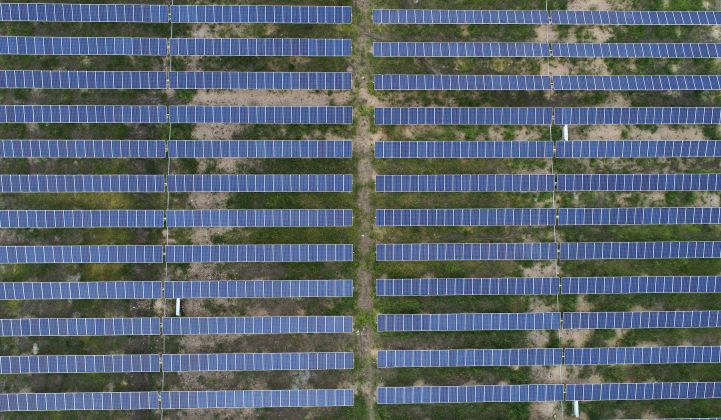Solar’s global shift from fringe to mainstream is a story made in China.
The likes of Jinko Solar, Trina Solar and Longi have dominated. They scaled first and fast — with more than a little help from the government — to capitalize on PV technology’s development into a 100+ gigawatt annual market.
Solar is establishing itself as the cheapest form of power across much of Europe, giving it a pivotal role in the continent’s drive toward net-zero. Now, there is growing momentum for the modules to be made in Europe. As plans for a post-pandemic economic recovery gather pace, the appeal of green jobs is expanding and the solar industry takes on strategic importance.
A host of European solar manufacturers are looking to step up to the plate and deliver the next generation of PV technology. They, too, hope to benefit from policy frameworks created to prop up net-zero ambitions.
The trade body SolarPower Europe has established a solar manufacturing accelerator with companies across the solar value chain. Here we focus on companies looking to deliver cells and modules only.
(GTM Squared subscribers can get a deep dive on some of the companies featured in this article.)
Meyer Burger: 5 GW, cells and modules
Meyer Burger has an inside track on China’s solar manufacturing push, providing much of the equipment going into China's PV factories over the past decade of growth. Such manufacturing tools have made many of the new cell and module innovations possible.
Over time, however, the Swiss firm saw its pricing collapse even as its ideas proliferated. It decided to stop selling manufacturing equipment and use its technology to make modules of its own.
Having recently raised fresh funds and acquired former facilities used by Germany's SolarWorld, Meyer Burger is now readying production lines for 400 MW of cells and modules in the first half of next year. It hopes to scale up to 5 GW by 2026.
As well as banking on technological advantages, Meyer Burger CEO Gunter Erfurt says a lower embedded carbon footprint will be another draw as the industry continues to mature. Erfurt is advocating for policies to back low-carbon, high-tech solar procurement in Europe.
Genuine Europe Solar: 2 GW, wafers, cells and modules
A consortium led by Switzerland's EcoSolifer opened a 100 MW heterojunction factory in Hungary this summer using Meyer Burger technology. The plan is to quickly dial the factory up to 350 MW of capacity before more gradually scaling to 2 GW over the next few years.
EcoSolifer plans to use a range of European innovations, including silicon wafers from NexWafe, once the company’s production is up and running. NexWafe, a German research spinoff, makes the super-thin pieces of silicon required for solar cells without using the dominant method of sawing, which is wasteful and more expensive. It is likely to also provide wafers to Meyer Burger.
3Sun: 3.3 GW, cells and modules
The only contender on the list owned by a major player in the energy sector, 3Sun is part of Italian utility giant Enel. In 2019, the firm switched on a 200 MW production line producing heterojunction technology, and plans are afoot to grow the facility in Sicily to 3.3 GW of capacity by 2023-2024.
The utility invested €80 million ($94.4 million) into that first stage of manufacturing. Having funded 3Sun since it took sole ownership in 2014, Enel will doubtless be keen to see the firm start generating some revenue.
Enel Green Power owns one of the world's largest fleet of renewable energy assets, with more than 40 GW on its books. Enel is aiming to expand its solar capacity from 2.8 GW in 2019 to 8.8 GW in 2022.
RCT Solutions: 5 GW, cells and modules
The "5 GW + Green Fab" project is a collaboration between PV technology specialist RCT Solutions and a host of research institutes and industry groups including Germany’s Fraunhofer ISE and VDMA. The consortium is in negotiations to secure €500 million ($590 million) of financing from investors, and it hopes to be able to rapidly develop a manufacturing facility with 5 GW of capacity by 2023.
RCT has some recent experience in ramping big solar factories. It was the key partner in the development of an integrated gigafactory in Turkey, operated by Kalyon Solar. After tendering for construction in March 2017, the first 500 MW of production capacity began operating this summer.
Oxford PV: 10 GW, cells
Oxford PV's proposition diverges a bit from the other companies discussed here, but it could provide a real differentiator for its customers. The company has developed a transparent perovskite solar cell, which manufacturers can stack on top of a regular cell and reap the benefit of additional power generation. A commercial production line is being established in Germany, with hopes of having the 125 MW setup online by mid-2021. Strategic investors include Meyer Burger, Norwegian oil major Equinor and Chinese wind turbine manufacturer Goldwind.
Frank P. Averdung, CEO of Oxford PV, told GTM that as Chinese firms see the potential of their technology peak at 25.5 percent, they’ll be left to compete on cost alone. The theory bears out: Jinko Solar has nearly doubled its manufacturing capacity in the space of a year as it looks to maximize existing tech and prepare for that battle on cost.
“That’s when we come to the rescue," said Averdung.
Oxford PV’s cells will lead to more megawatt-hours being generated, but they won’t add to the number of megawatts of total solar capacity, given that they are paired with a regular solar cell.
***
The European Commission has set out along the road to achieving a climate-neutral economy by 2050. But where do the opportunities lie, and which technologies are poised to benefit?
Wood Mackenzie has launched a European Green Deal guide to help businesses understand how the European Green Deal will shape the future energy market and evaluate the potential new opportunities. Click here to find out more.




